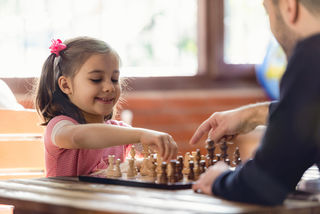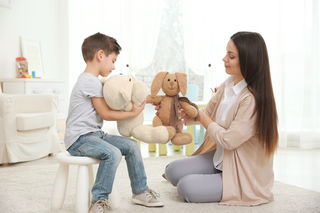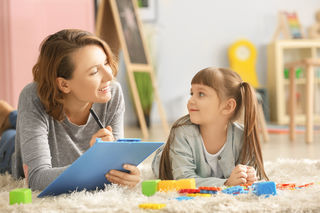
Play
Is My Child's Therapy Just Play Time?
Why do elementary-aged kids spend so much session time playing?
Posted December 28, 2019 Reviewed by Davia Sills

Many children, when asked how their therapy is going, describe sessions full of games and playtime. This often leaves parents feeling confused, or even lied to, wondering if their hard-earned copays are being wasted on glorified babysitting. But rest assured that play does have its place in therapy, especially for elementary-aged children.
Here are some reasons your child might be playing during their sessions.
Building Rapport With Your Child
A strong, positive relationship between a therapist and their client is the foundation of successful therapy and the most important factor in making progress toward treatment goals. For this reason, the first several sessions are often dedicated entirely to rapport-building or the development of this therapeutic relationship.
Counselors who work with elementary-aged children use games and play to build trust, establish a positive therapy experience, and create a comfortable atmosphere while their clients get to know them. Board and card games allow children to see that their therapist follows the rules, acts in a predictable manner, and will not get upset if things don’t go their way.
Games with clear rules also set children at ease by giving them easy-to-follow guidelines for how to behave in this unfamiliar social territory. Playtime in the first few sessions also creates a positive therapy experience, making children eager to return for and more likely to participate in later sessions.

Getting to Know Your Child
Play is also a unique opportunity for your child’s therapist to get to know your child. It is one thing to hear you describe your child’s tantrums and an entirely different thing to witness one when your child loses a close game of Uno. Similarly, how your child interacts with their clinician during playtime is often a window into how they treat other children.
For elementary-age children, there are significant social consequences for being a bossy playmate, too hands-on, a sore loser, or a gloating winner. Playing during therapy sessions allows your child’s counselor to identify areas where your child may need additional social and coping skill development.
Games are also extremely helpful in facilitating conversation between a child and their therapist. Most children are far more comfortable answering questions when they are asked casually during a game, and the game also makes silences less uncomfortable.
Teaching Therapeutic Skills
Counselors who work with children often keep therapy interesting and meaningful by using games, crafts, or other fun activities to teach essential social and emotional skills. For example, a clinician might play a game of Jenga in which the child must name something that helps them relax every time they pull out a Jenga block.
Games that require acting out social situations and coping strategies are particularly helpful because it’s easier to recall and use a skill when you have practiced it in a situation similar to the one in which you will actually use it. This therapeutic role-playing can be easily made into a game of charades. And if you have to practice deep breathing or walking away when someone is teasing you, wouldn’t you rather do it to earn points and win a game? So would your child!
Rewarding Hard Work
Play can also be used as a reward to give children an incentive to participate in therapeutic discussions and activities. Using playtime as a reward can be particularly helpful with children who are easily distracted or use avoidance strategies to try to run out the clock on their session.
For example, a therapist might state that a child must spend 25 minutes engaged in a therapeutic activity—say, discussing an outburst that happened earlier in the week and how the situation could have been handled differently—and after the time has elapsed, the child can choose a game for playtime. The therapist can then set a timer for 25 minutes, and every time the child is off-task or not participating, the timer gets paused. Children quickly make the connection that the longer they spend avoiding participation, the less playtime they will have left when the timer goes off.

Practicing Play Therapy
Play therapy is a specific type of therapy based on the theory that young children process their emotions and experiences through play. (Have you ever noticed that “mommy bear” and “daddy bear” can sound an awful lot like someone you know?) Clinicians who are trained in play therapy often spend the majority of their sessions playing with their young clients, using the symbolism present in the play to suggest new modes of behavior and model appropriate coping strategies.
For example, a child who has been suddenly removed from their home environment might have a repeated theme in their play of one character being “stolen” or “taken away.” This character might then try to escape from their new environment, trying to be reunited with whomever they were “stolen” from. Depending upon the child’s real-life situation, a play therapist might play the part of other characters who help the “stolen” character feel more comfortable in their new home, characterize the old environment as scary or unsafe, or suggest the “stolen” character call or write the person they were “stolen” from.

Whatever the reason for your child’s playtime in therapy, it is one step on the way to your child meeting his or her treatment goals. Keep in mind that when asked about their therapy sessions, many children discuss the play portion of therapy because it is the most exciting part for them, as well as to avoid mentioning more emotionally charged parts of their therapy. It’s much easier to talk about how thoroughly you beat your therapist at Don’t Spill the Beans than to describe how you and your therapist processed the playground fight that got you suspended last week.
But if you are still worried that your child is not getting enough out of their therapy, discuss your concerns with your child’s therapist. You may discover that your child is making slow but steady progress toward his or her goals in ways you hadn’t expected!



